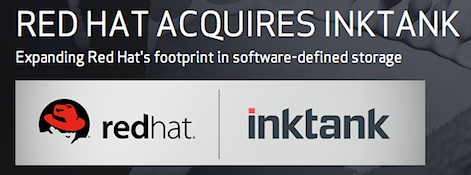München, Starnberg, 2. Mai 2014 – Red Hat erweitert Storage-Aquise: Nach GlusterFS mit File- und Object Storage nun Ceph mit RADOS Blockzugriff für OpenStack Clouds…
Zum Hintergrund: open Software Definded Storage gewinnt an Marktdynamik. Nach der Aquise von GlusterFS plant der Enterprise Open Source Storage Softwareanbieter Red Hat nun auch im Block-basierten Bereich für OpenStack-Clouds eine Übernahme. Ziel ist der Übernahme ist das Unternehmen Inktank, Anbieter von Scale-Out-, Open-Source-Storage-Systemen und Entwickler von Ceph, einem relativ verbreiteten Open-Source - Software-defined Speichersystem, das auf Commodity-Hardware läuft. Ceph Enterprise bietet Unternehmen, die eine Public oder Private Cloud nutzen, sowohl Object- als auch Block-basierte Storage-Software-Funktionen über RADOS Block Device (RBD), die auch in OpenStack Cloud Umgebungen zum Einsatz kommt. Zusammen mit Red Hats bestehendem GlusterFS-macht die Akquisition von Inktank Red Hat zum Komplettanbieter von offenen Software-defined Storagelösungen im Bereich von Object-, Block- und Filesystem-Speicher.
Nachfolgend ein Auszug der Original-Beschreibung von Inktank RADOS. Quelle siehe: http://ceph.com/ceph-storage/block-storage/
- Ceph’s object storage system isn’t limited to native binding or RESTful APIs. You can mount Ceph as a thinly provisioned block device! When you write data to Ceph using a block device, Ceph automatically stripes and replicates the data across the cluster.
- Ceph’s RADOS Block Device (RBD) also integrates with Kernel Virtual Machines (KVMs), bringing Ceph’s virtually unlimited storage to KVMs running on your Ceph clients.
Ceph RBD interfaces with the same Ceph object storage system that provides the librados interface and the Ceph FS file system, and it stores block device images as objects. Since RBD is built on top of librados, RBD inherits librados capabilites, including read-only snapshots and revert to snapshot. By striping images across the cluster, Ceph improves read access performance for large block device images.
Daraus ergeben sich direkte Vorteile gerade bei großen Block Device Images:
- Thinly provisioned
- Resizable images
- Image import/export
- Image copy or rename
- Read-only snapshots
- Revert to snapshots
- Ability to mount with Linux or QEMU KVM clients
Zu diesem Thema hat Red Hat am 30. April einen Webcast veranstaltet. Falls Sie an der Aufzeichnung interessiert sind, ist eine Registrierung hier möglich.
Zitat Sage Weil, founder and CTO, Inktank: "With a shared commitment to open source, open standards and customer success, joining forces with Red Hat is something we are all very excited about. We believe our open storage technologies will be critical in the management of data in the coming era of cloud computing. Joining Red Hat will no doubt lead to tremendous innovation that will ultimately serve the industry well and answer the demand for open storage solutions fully integrated with existing and emerging data center architectures such as OpenStack.”
Brian Stevens, executive vice president and CTO, Red Hat: "We’re thrilled to welcome Inktank to the Red Hat family. They have built an incredibly vibrant community that will continue to be nurtured as we work together to make open the de facto choice for software-defined storage. Inktank has done a brilliant job assembling a strong ecosystem around Ceph and we look forward to expanding on this success together. The strength of these world-class open storage technologies will offer compelling capability as customers move to software-based scale-out storage systems.
Blog von Sage Weil, founder and CTO, Inktank: http://ceph.com/community/red-hat-to-acquire-inktank/
Ceph: http://ceph.com/

